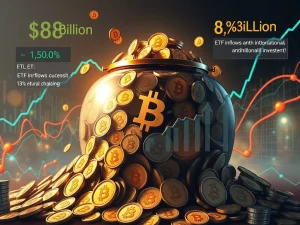Grayscale Bitcoin Trust: Why Its Astonishing Revenue Dominance Continues in 2025

In the competitive world of cryptocurrency investments, the **Grayscale Bitcoin Trust** (GBTC) has achieved a remarkable feat. Despite facing significant competition and investor outflows since converting to a spot **Bitcoin ETF** in early 2024, GBTC continues to generate more **ETF revenue** than all other US spot Bitcoin ETFs combined. This surprising dominance raises questions about market dynamics, investor behavior, and Grayscale’s strategy.
How Does GBTC Maintain Revenue Dominance Despite High Fees?
The core of GBTC’s revenue strength lies in its **expense ratio**. At 1.5%, it is significantly higher than its competitors. For example:
- GBTC: 1.5%
- BlackRock IBIT: 0.25%
- Fidelity FBTC: 0.25%
- Bitwise BITB: 0.24%
- Franklin Templeton EZBC: 0.19%
Even with substantial outflows ($18 billion since early 2024), GBTC still holds a significant amount of assets under management (AUM), approximately $18 billion. When you apply a 1.5% fee to $18 billion, it generates roughly $268.5 million in annual revenue. This figure surpasses the combined revenue of other US spot Bitcoin ETFs, which collectively manage a much larger AUM ($89 billion) but at much lower fee rates (totaling about $211.8 million in revenue).
What Factors Contribute to GBTC’s Enduring Strength?
Beyond the high **expense ratio**, several factors help explain why **GBTC** retains a loyal, albeit shrinking, investor base:
- **Legacy and Trust:** Launched in 2013, Grayscale was a pioneer in providing regulated access to Bitcoin. Its long history and legal victory against the SEC to convert to an ETF have built a level of trust among certain investors.
- **Tax Friction:** Many long-term GBTC holders acquired shares at much lower Bitcoin prices. Selling these shares to move to a lower-fee ETF would trigger significant capital gains taxes for investors in taxable accounts. This tax burden acts as a powerful disincentive to switch.
- **Institutional Inertia:** Large institutions, family offices, and companies that invested in GBTC years ago may face internal hurdles, mandates, or tax implications that prevent them from quickly reallocating their positions, even if lower-fee options are available.
While newer **Bitcoin ETF**s like BlackRock’s IBIT attract massive inflows with competitive fees and high trading volumes, GBTC’s established base, protected by tax barriers and historical loyalty, continues to fuel its leading **ETF revenue**.
How is Grayscale Responding to Competition?
Grayscale is not ignoring the competitive pressure. In March 2025, they launched the Grayscale Bitcoin Mini Trust (BTC) with a significantly lower **expense ratio** of 0.15%. This product is designed to appeal to cost-sensitive investors and potentially retain assets within the Grayscale ecosystem. However, the Mini Trust’s lower fee structure means it generates substantially less revenue per dollar of AUM compared to the flagship GBTC, further highlighting why GBTC’s high-fee engine remains the primary revenue driver for the company for now.
What Does This Mean for the Future of Bitcoin ETF Revenue?
The current landscape shows a clear split: new ETFs capturing the majority of new capital with low fees, and **Grayscale Bitcoin Trust** maintaining revenue leadership through a high fee on a large, sticky asset base. As tax implications potentially diminish over time (as investors eventually need to sell or pass on assets) and competition intensifies, GBTC’s revenue share may eventually decrease. However, its current dominance underscores the significant impact of legacy positions and tax considerations in financial markets, proving that the simple arithmetic of low fees doesn’t always immediately translate into the highest revenue in a rapidly evolving market like that of the **Bitcoin ETF**.









